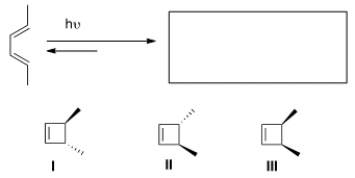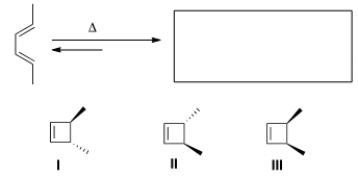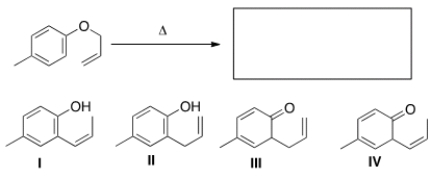A) Only I
B) Only II
C) Only III
D) Only I and II
Correct Answer

verified
Correct Answer
verified
Multiple Choice
How many bonding molecular orbitals are present in 1,3,5-hexatriene?
A) 3
B) 4
C) 5
D) 6
Correct Answer

verified
Correct Answer
verified
Multiple Choice
Which of the following statements about pericyclic reactions is not true?
A) Pericyclic reactions are concerted reactions.
B) Pericyclic reactions proceed through a cyclic transition state.
C) Pericyclic reactions are not stereospecific.
D) Pericyclic reactions require light or heat.
Correct Answer

verified
Correct Answer
verified
Multiple Choice
Which of the following statements about the Cope rearrangement is not true?
A) The Cope rearrangement involves the rearrangement of a 1,5-diene to an isomeric 1,5-diene.
B) The Cope rearrangement takes place readily in a suprafacial pathway under photochemical conditions.
C) The Cope rearrangement involves three electron pairs; two in bonds and one in a bond.
D) The Cope rearrangement takes place readily in a suprafacial pathway, when heated.
Correct Answer

verified
Correct Answer
verified
Multiple Choice
Which of the following statements about cycloaddition reactions is true?
A) Cycloaddition reactions occur only intermolecularly.
B) Cycloaddition reactions occur only intramolecularly.
C) Cycloaddition reactions form a cyclic product with two new bonds.
D) Cycloaddition reactions can be intramolecular or intermolecular.
Correct Answer

verified
Correct Answer
verified
Multiple Choice
What type of cycloaddition reaction is shown below? ![What type of cycloaddition reaction is shown below? A) [2+2] B) [4+2] C) [4+4] D) [0+2]](https://d2lvgg3v3hfg70.cloudfront.net/TB5871/11ea9088_7054_5b5a_aec7_e5bd9bd95306_TB5871_00_TB5871_00_TB5871_00_TB5871_00_TB5871_00_TB5871_00_TB5871_00.jpg)
A) [2+2]
B) [4+2]
C) [4+4]
D) [0+2]
Correct Answer

verified
Correct Answer
verified
Multiple Choice
Which of the following statements about pericyclic reactions is true?
A) Pericyclic reactions occur by way of ionic intermediates.
B) Pericyclic reactions occur by way of radical intermediates.
C) Pericyclic reactions involve multiple steps.
D) Reactive intermediates are not formed in pericyclic reactions.
Correct Answer

verified
Correct Answer
verified
Multiple Choice
Predict the major organic product(s) of the following electrocyclic reaction. 
A) Only I
B) Only II
C) Only III
D) Only I and II
Correct Answer

verified
Correct Answer
verified
Multiple Choice
Which of the following statements about the Claisen rearrangement is true?
A) The Claisen rearrangement occurs readily in a suprafacial pathway under photochemical conditions.
B) The Claisen rearrangement occurs readily in an antarafacial pathway under thermal conditions.
C) The Claisen rearrangement involves three electron pairs; two in bonds and one in a bond.
D) The Claisen rearrangement involves the rearrangement of an unsaturated ether to a ,-unsaturated carbonyl compound.
Correct Answer

verified
Correct Answer
verified
Multiple Choice
Which of the following statements about sigmatropic rearrangements and orbital symmetry is not true?
A) Reactions involving six atoms or fewer must take place by suprafacial pathways.
B) In a suprafacial rearrangement, the new bond forms on the opposite side of the system as the broken bond.
C) In an antarafacial rearrangement, the new bond forms on the opposite side of the system as the broken bond.
D) In a suprafacial rearrangement, the new bond forms on the same side of the system as the broken bond.
Correct Answer

verified
Correct Answer
verified
Multiple Choice
Predict the major organic product(s) of the following electrocyclic reaction. 
A) Only I
B) Only II
C) Only III
D) Only I and II
Correct Answer

verified
Correct Answer
verified
Multiple Choice
Which of the following is not a correct designation for a sigmatropic rearrangement?
A) [1,3]
B) [1,5]
C) [3,3]
D) [3,1]
Correct Answer

verified
Correct Answer
verified
Multiple Choice
What is the major organic product of the following Claisen rearrangement? 
A) I
B) II
C) III
D) IV
Correct Answer

verified
Correct Answer
verified
Multiple Choice
How many molecular orbitals are present in 1,3,5,7,9-decapentaene?
A) 4
B) 5
C) 10
D) 12
Correct Answer

verified
Correct Answer
verified
Multiple Choice
Which of the following statements about electrocyclic reactions is true?
A) An electrocyclic reaction is generally irreversible.
B) Generally, an acyclic triene is favored over a six-membered ring at equilibrium.
C) Generally, a four-membered ring is favored over an acyclic diene at equilibrium.
D) An electrocyclic reaction is generally reversible.
Correct Answer

verified
Correct Answer
verified
Multiple Choice
What type of sigmatropic rearrangement is illustrated below? ![What type of sigmatropic rearrangement is illustrated below? A) [1,3] B) [1,4] C) [3,3] D) [1,5]](https://d2lvgg3v3hfg70.cloudfront.net/TB5871/11ea9088_7055_e1fe_aec7_7f52f6e27045_TB5871_00_TB5871_00_TB5871_00_TB5871_00_TB5871_00_TB5871_00_TB5871_00.jpg)
A) [1,3]
B) [1,4]
C) [3,3]
D) [1,5]
Correct Answer

verified
Correct Answer
verified
Multiple Choice
Which of the following statements about pericyclic reactions is true?
A) In pericyclic reactions, bonds are broken and formed in multiple steps.
B) In pericyclic reactions, all bonds are broken and formed in a single step.
C) One intermediate has been identified in pericyclic reactions.
D) The transition state in a pericyclic reaction is acyclic.
Correct Answer

verified
Correct Answer
verified
Multiple Choice
What type of sigmatropic rearrangement is illustrated below? ![What type of sigmatropic rearrangement is illustrated below? A) [1,3] B) [1,4] C) [3,3] D) [1,5]](https://d2lvgg3v3hfg70.cloudfront.net/TB5871/11ea9088_7055_baed_aec7_af99f6635d03_TB5871_00_TB5871_00_TB5871_00_TB5871_00_TB5871_00_TB5871_00_TB5871_00.jpg)
A) [1,3]
B) [1,4]
C) [3,3]
D) [1,5]
Correct Answer

verified
Correct Answer
verified
Multiple Choice
Which of the following statements about photochemical electrocyclic reactions is not true?
A) In photochemical reactions, we consider the orbitals of the HOMO of the excited state to determine the course of the reaction.
B) Photochemical electrocyclic reactions occur in a conrotatory fashion for a conjugated polyene with an odd number of bonds.
C) Photochemical electrocyclic reactions occur in a disrotatory fashion for a conjugated polyene with an even number of bonds.
D) In photochemical reactions, we consider the orbitals of the LUMO of the excited state to determine the course of the reaction.
Correct Answer

verified
Correct Answer
verified
Multiple Choice
Which of the following statements about a thermal reaction involving an even number of electron pairs is true?
A) A thermal reaction involving an even number of electron pairs is conrotatory or antarafacial
B) A thermal reaction involving an even number of electron pairs is disrotatory or suprafacial
C) A thermal reaction involving an even number of electron pairs is conrotatory or suprafacial
D) A thermal reaction involving an even number of electron pairs is disrotatory or antarafacial
Correct Answer

verified
Correct Answer
verified
Showing 21 - 40 of 52
Related Exams